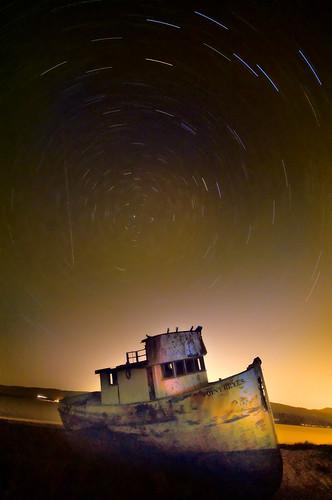
Star Circles, photo by Harold Davis. View this image larger.
Two thousand four hundred seconds, about forty minutes. Actually longer, maybe three thousand five hundred seconds, or close to an hour, when you add in-camera noise reduction.
I have mixed emotions when it comes to exposures that take this long. You don’t get many cracks at getting the exposure right. For one thing, each exposure drains a battery. Conditions change, and the night is only so long. Someone (or something like a car, boat, or plane) might shine a light in the direction of the camera. In the end, the LCD display is unreliable (it overcompensates for lousy exposures), so you can’t judge very well in the field (the exposure histogram gives better information).
So making these captures I feel every inch the heroic photographer in the tradition of the pioneers who made their subjects hold still for hours during an exposure (and then waited days for the wet plates to dry!). Of course, I also feel like a klutz when the exposure doesn’t come out, or the visual concept doesn’t hold up in the actual image.
On a more human element, I am measuring time as it passes. Sometimes I pace, sometimes I stand still. I try sitting or lying down, but the ground is too damp and cold. Each second can seem like eternity. There are thousands of seconds weighing me down.
I’m bundled against the wind and moisture in wool layers, poly piling, down, with a balaclava pulled down over my head. Is this water drop slow torture, or is it sublime as my city sensibility gradually clears, and I observe the night, forced to take the time to see things that are a cipher to most folk.
Other Star Trawler images: Big Dipper; Pole Star; The Long and Short; Star Trawler.
[Nikon D300, 12-24mm zoom lens at 12mm (18mm in 35mm terms), 2,407 seconds (about 40 minutes) at f/13 and ISO 100, tripod mounted.]
Pingback: Photoblog 2.0: » Photoblog 2.0 Archive: » 2,407 Seconds